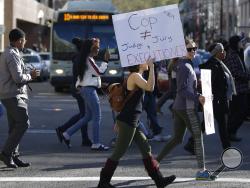SACRAMENTO, Calif. (AP) — Protesters decrying this week's fatal shooting of an unarmed black man marched from Sacramento City Hall and onto a nearby freeway Thursday, disrupting rush hour traffic and holding signs with messages like "Sac PD: Stop killing us!"
Hundreds of people rallied for Stephon Clark, a 22-year-old who was shot Sunday in the backyard of his grandparents' home. Police say they feared he had a handgun when they confronted him after reports that he had been breaking windows in the South Sacramento neighborhood.
But police found only a cellphone.
"We are at a place of deep pain" because of recent violence directed at black people in Sacramento and elsewhere, said the Rev. Les Simmons, a community leader. He said the city's first black police chief, Daniel Hahn, is doing what he can but protested the actions of Hahn's officers.
Clinton Primm said he was friends with Clark, who was nicknamed "Zoe," for about six years and fears others are also at risk at being shot by police.
"He was a great dad," he recalled of Clark, the father of sons ages 1 and 3. "He loved both of them to death."
Sacramento resident Vanessa Cullars said she has lost two family members to police violence.
"I'm fed up with this," she said at the protest. "I feel like our lives don't matter to them."
Sacramento Mayor Darrell Steinberg earlier said he was horrified but won't second-guess the "split-second decisions" of the officers. He praised Hahn for quickly releasing videos of the shooting and said the department has improved its policies since the fatal shooting of a mentally ill black man in 2016.
But independent experts said the footage from body cameras and an overhead helicopter raises more questions than it answers.
The officers appeared to believe they were in danger, they said, and if so the shooting was likely legally justified.
One officer is heard "doing a mental inventory to make sure there's no holes in his body" because the officers appear to think Clark may have shot at them and missed, said Peter Moskos, a former police officer and assistant professor in the Department of Law and Police Science at John Jay College of Criminal Justice.
But Geoffrey Alpert, a professor of criminology at the University of South Carolina and an expert on police use of force, said the officers may have a tough time explaining why they jumped to the conclusion that Clark had a gun.
He also questioned why an arriving backup officer had the two original officers turn off the microphones on their body cameras, eliminating what he called "important evidence."
In an ideal world, the two officers should have immediately provided first aid instead of waiting five minutes for backup, said Eugene O'Donnell, a professor of police studies at John Jay College of Criminal Justice. "But that could be more the product of hope than reality," he said, with the officers still in shock and worried about their own safety.
The Sacramento Police Department said officers were responding to reports of a man seen breaking into at least three vehicles and later into a neighbor's home. The police said deputies in the helicopter saw Clark break a neighbor's sliding glass door before jumping a fence.
As a result, "their threat radar is really high," said Plumas County sheriff's deputy and special prosecutor Ed Obayashi, who trains officers and testifies in court on police use of force.
"They have to assume that their lives are in danger at that very second," he said.
__
By SOPHIA BOLLAG and DON THOMPSON, Associated Press
__
Associated Press writers Jonathan J. Cooper and Kathleen Ronayne contributed.

